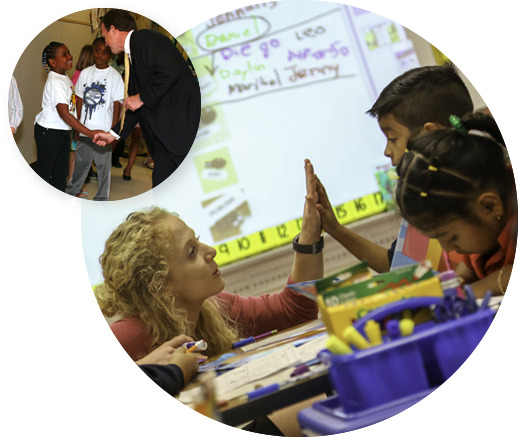Positive Behavior Interventions and Supports (PBIS) is a behavioral-management framework that establishes the social culture and behavioral supports children need to achieve both social and academic success. (Horner, Sugai, Lewis, 2015).

Leader in Me and PBIS share important goals and approaches, which may be why a growing number of PBIS schools implement LiM to drive long-term improvements in school culture and student behavior.
Leader in Me (LiM) is a schoolwide transformation process that builds social emotional skills, a strong sense of belonging, and positive student-teacher and student-student relationships. This is shown to be one of the most effective methods for helping students, especially those who exhibit negative behaviors.
LiM supports PBIS by:
Common approaches to behavior management typically involve educators responding to inappropriate student behavior with negative measures, reinforcing external control, and often diminishing trust among stakeholders. Both LiM and PBIS use preventative and positive forms of behavioral management.
Leader in Me |
SHARED GOALS + APPROACHES |
PBIS |
||
| Direct and integrated teaching of social emotional skills. | → | LEADERSHIP PRACTICES
Promotes
|
← | Instruction on codes of conduct through behavior expectations. |
| Positive behavior is supported through self-regulation. | → | CULTURAL SYSTEMS
Improves school environment. |
← | Positive behavior is supported through teacher-centered strategies. |
| Based on principles of effective leadership and social, cognitive, and developmental theory. | → | ACADEMICS + DATA TRACKING
Establishes data-driven decision making.
|
← | Based on behavioral psychology and applied behavioral analysis. |

Both PBIS and LiM support the idea of a leadership team to oversee the initial implementation. In practice, having two teams means priorities can overwhelm educators and lead to the poor implementation of both initiatives.
Leader in Me training provides:
The process is led by a Staff Lighthouse Team and Staff Action Teams. Collaboration with Staff, Student, and Family/Community Action Teams and unity toward shared schoolwide goals and outcomes through schoolwide, classroom, and personal goal alignment is the key to success.

To be successful in the long term, a connection needs to be made between short-term external rewards and long-term internal skill building.
Leader in Me Schools provide students with opportunities to develop intrinsic motivation while recognizing that external rewards, if linked to collaboration and teamwork, can build a positive school culture and encourage students to persevere.
Students lead classroom, grade-level, and schoolwide events that reinforce social competencies like collaboration, social awareness, and empathy while also reinforcing personal competencies like perseverance, goal-directed behavior, and self-management.
Specific practices include:

A key aspect of both PBIS and LiM is using data to inform decision making. For PBIS, data on discipline referrals and suspensions provides important information on how the practices are impacting behavioral outcomes. However, without additional data on behavior and attitude changes, a lack of knowledge on how to improve school culture is lacking.
Leader in Me Schools use the Measurable Results Assessment (MRA) to combine student, staff, and family attitudes and behavior growth with schoolwide data on disciplinary referrals, suspensions, retention, and state test scores. This combined data enables schools to see a comprehensive story of growth and identify areas for improvement.